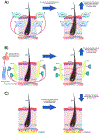Mini-review of hair cortisol concentration for evaluation of Cushing syndrome
- PMID: 30234410
- PMCID: PMC6378952
- DOI: 10.1080/17446651.2018.1517043
Mini-review of hair cortisol concentration for evaluation of Cushing syndrome
Abstract
Introduction: The diagnosis of endogenous Cushing syndrome is often challenging and requires multiple repeated blood, urine, and saliva tests to detect elevated cortisol levels. Hair cortisol concentration has been described as a marker of long-term exposure to systemic cortisol in patients with Cushing syndrome. Like hemoglobin A1c is used to detect serum glucose exposure over months, segmental hair cortisol can help identify patients with milder forms of and/or periodic or cyclical Cushing syndrome, which may reduce time and costs associated with collection of urine, salivary, and serum cortisol.
Areas covered: Success of hair cortisol in detection of Cushing syndrome will be discussed in context of current literature, including differences between total or segmental hair cortisol in accurately determining timeline of cortisol exposure. Optimal methods of hair collection, storage, processing, and analysis and efforts toward standardization will be a major focus.
Expert commentary: Recent evidence suggests increased sensitivity and specificity of hair cortisol in detecting Cushing syndrome. Future guidelines should consider this test as a routine part of the repertoire of screening tests for Cushing syndrome. Possible confounders to explain discrepant results in the literature will be discussed.
Trial registration: ClinicalTrials.gov NCT00001595 NCT00005927.
Keywords: Cushing disease; Cushing syndrome; Hair; cortisol; hair cortisol; hypercortisolemia.
Conflict of interest statement
Declaration of interest
The authors have no relevant affiliations or financial involvement with any organization or entity with a financial interest in or financial conflict with the subject matter or materials discussed in the manuscript. This includes employment, consultancies, honoraria, stock ownership or options, expert testimony, grants or patents received or pending, or royalties.
Figures


Similar articles
-
Hair cortisol in the evaluation of Cushing syndrome.Endocrine. 2017 Apr;56(1):164-174. doi: 10.1007/s12020-017-1231-7. Epub 2017 Feb 13. Endocrine. 2017. PMID: 28194652 Free PMC article.
-
Reassessing the reliability of the salivary cortisol assay for the diagnosis of Cushing syndrome.J Int Med Res. 2013 Oct;41(5):1387-94. doi: 10.1177/0300060513498017. Epub 2013 Sep 24. J Int Med Res. 2013. PMID: 24065452 Review.
-
Hair cortisol and cortisone measurements for the diagnosis of overt and mild Cushing's syndrome.Eur J Endocrinol. 2021 Mar;184(3):445-454. doi: 10.1530/EJE-20-1127. Eur J Endocrinol. 2021. PMID: 33449913
-
Clinical applications of cortisol measurements in hair.Eur J Endocrinol. 2015 Oct;173(4):M1-10. doi: 10.1530/EJE-15-0313. Epub 2015 Apr 29. Eur J Endocrinol. 2015. PMID: 25924811 Review.
-
Hair analysis provides a historical record of cortisol levels in Cushing's syndrome.Exp Clin Endocrinol Diabetes. 2010 Feb;118(2):133-8. doi: 10.1055/s-0029-1220771. Epub 2009 Jul 16. Exp Clin Endocrinol Diabetes. 2010. PMID: 19609841 Free PMC article.
Cited by
-
Lower hair cortisol among patients with sickle cell disease may indicate decreased adrenal reserves.Am J Blood Res. 2021 Apr 15;11(2):140-148. eCollection 2021. Am J Blood Res. 2021. PMID: 34079627 Free PMC article.
-
Hair cortisol and endocannabinoid measurement in patients with adrenal incidentalomas: a case-control study.Hormones (Athens). 2024 Mar;23(1):113-120. doi: 10.1007/s42000-023-00495-x. Epub 2023 Oct 4. Hormones (Athens). 2024. PMID: 37792214
-
Using music to soothe our patients, measuring hair cortisol, and machine learning in diabetes: Prof. Batrinos would have been very happy!Hormones (Athens). 2023 Dec;22(4):533-535. doi: 10.1007/s42000-023-00501-2. Hormones (Athens). 2023. PMID: 37945986 No abstract available.
-
Cyclic Cushing's Syndrome - A Diagnostic Challenge.Front Endocrinol (Lausanne). 2021 Apr 22;12:658429. doi: 10.3389/fendo.2021.658429. eCollection 2021. Front Endocrinol (Lausanne). 2021. PMID: 33967962 Free PMC article. Review.
-
Pitfalls in the Diagnosis and Management of Hypercortisolism (Cushing Syndrome) in Humans; A Review of the Laboratory Medicine Perspective.Diagnostics (Basel). 2023 Apr 14;13(8):1415. doi: 10.3390/diagnostics13081415. Diagnostics (Basel). 2023. PMID: 37189516 Free PMC article. Review.
References
-
- Friedman TC, Ghods DE, Shahinian HK, et al. High Prevalence of Normal Tests Assessing Hypercortisolism in Subjects with Mild and Episodic Cushing’s Syndrome Suggests That the Paradigm for Diagnosis and Exclusion of Cushing’s Syndrome Requires Multiple Testing. Horm Metab Res. 2010;42(12):874–881. - PMC - PubMed
-
- Kidambi S, Raff H, Findling JW. Limitations of nocturnal salivary cortisol and urine free cortisol in the diagnosis of mild Cushing’s syndrome. Eur J Endocrinol. 2007;157(6):725–731. - PubMed
-
- Kreitschmann-Andermahr I, Psaras T, Tsiogka M, et al. From first symptoms to final diagnosis of Cushing’s disease: experiences of 176 patients. Eur J Endocrinol. 2015;172(6):X1. - PubMed
Publication types
MeSH terms
Substances
Associated data
Grants and funding
LinkOut - more resources
Full Text Sources
Other Literature Sources
Medical
